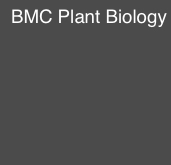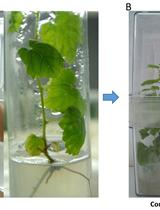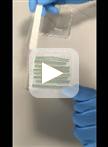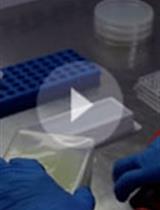- EN - English
- CN - 中文
A Reliable Method for Phytophthora cajani Isolation, Sporangia, Zoospore Production and in Planta Infection of Pigeonpea
一种可靠的分离疫霉属水霉、产生孢子囊和游动孢子以及感染木豆植株的实验方法
发布: 2016年01月20日第6卷第2期 DOI: 10.21769/BioProtoc.1706 浏览次数: 12556
评审: Samik BhattacharyaShahin S. AliAnonymous reviewer(s)
Abstract
Pigeonpea (Cajanus cajan L.) is an important legume crop of rainfed agriculture. High levels of protein in pigeonpea make it a valuable protein source for developing countries. Phytophthora blight caused by Phytophthora cajani (P. cajani) is a potential threat to pigeonpea (Cajanus cajan L.) production, affecting the crop irrespective of cropping system, cultivar grown and soil types (Pande et al., 2011; Sharma et al., 2006). The primary mode of infection of P. cajani is sporangium and zoospore. Therefore, sensitive and reliable methods for zoospore production and estimating infection severity are desirable in case of Phytophthora blight of pigeonpea (Sharma et al., 2015). Here we present a protocol for isolation of P. cajani from infected plants, sporangia and zoospore production and in planta infection technique of pigeonpea seedlings. These methods will be important tool to devise a platform for rapid and reliable screening against Phytophthora blight disease of pigeonpea as well as for host x pathogen x environment interaction studies.
Keywords: Phyophthora cajani (phyophthora cajani)Materials and Reagents
- Cotton (Jaycot Industries)
- Glass slide (75 x 25 x 1.35 mm) (Blue star)
- Parafilm (Sigma-Aldrich, catalog number: P7793 )
- Petri dish (100 x 19.5 mm) (Borocil, catalog number: 5550300 )
- Phytophthora cajani isolate ICPC 1 (NCBI, GenBank Acc, catalog number: 10534 )
- Pigeonpea seedlings, cultivar ICP 7119
- Agar (HiMedia Laboratories, catalog number: RM201 )
- Ampicillin (Srlchem, catalog number: 61314 )
- Calcium carbonate (CaCO3) (HiMedia Laboratories, catalog number: GMR 397 )
- Dextrose (HiMedia Laboratories, catalog number: GRM077 )
- Dimethyl sulfoxide (DMSO) (Sigma-Aldrich, catalog number: 472301 )
- Ethanol
- Pentachloronitrobenzene (PCNB) (Purity: ≥ 94%) (Sigma-Aldrich, catalog number: P2205 )
- Pimaricin (Sigma-Aldrich, catalog number: P9703 )
- Rifampicin (Sigma-Aldrich, catalog number: R7382 )
- Sodium hypochlorite (Scribd Inc., Qualigens, catalog number: 27905 )
- Sterilized pond water
- Sterilized water
- Sterilized river sand
- V8 Agar media (HiMedia Laboratories, catalog number: M638 )
- Vermiculite (locally available)
- Tomato juice
- Tomato juice agar (see Recipes)
- V8 juice agar (see Recipes)
- PARP solutions (see Recipes)
- Tomato broth (see Recipes)
Equipment
- Autoclave (Tomy Seiko)
- Beaker (100 and 400 ml) (Borocil, catalog number: 1000D16 and 1000D23 )
- Conical flask (50 ml) (Borocil, catalog number: 4060012 )
- Cork borer (approximately 5 mm diameter)
- Greenhouse (25-28 °C)
- Haemocytometer (1/400 mm2 and 1/10 mm deep) (Sigma-Aldrich)
- Hot air oven (Thermo Fisher Scientific)
- Incubator (Temperature range: 5-60 °C, humidity: 0-100%) (Tomy Percival)
- Inoculating needle
- Horizontal laminar flow clean benches (Esco Micro Pte, Labculture, model: LHC-4C )
- Light microscope (OLYMPUS)
- Measuring cylinder (100 ml) (Borocil, catalog number: 3024016 )
- Plastic tray (30 x 48 x 10 cm)
- Test tube (18 x 150 mm) (Borocil, catalog number: 9820U06 )
Procedure
文章信息
版权信息
© 2016 The Authors; exclusive licensee Bio-protocol LLC.
如何引用
Sharma, M. and Ghosh, R. (2016). A Reliable Method for Phytophthora cajani Isolation, Sporangia, Zoospore Production and in Planta Infection of Pigeonpea. Bio-protocol 6(2): e1706. DOI: 10.21769/BioProtoc.1706.
分类
微生物学 > 微生物-宿主相互作用 > 真菌
微生物学 > 微生物-宿主相互作用 > 体内实验模型 > 植物
植物科学 > 植物免疫 > 病害生物测定
您对这篇实验方法有问题吗?
在此处发布您的问题,我们将邀请本文作者来回答。同时,我们会将您的问题发布到Bio-protocol Exchange,以便寻求社区成员的帮助。
Share
Bluesky
X
Copy link















